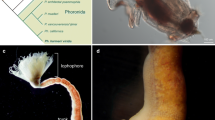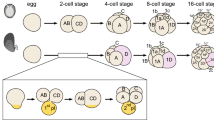Abstract
Gastrulation occurs by a variety of morphogenetic movements, often correlated with diverse expression of the T-box transcription factor Brachyury (Bra). Bra may be expressed in ectoderm, mesoderm, or endoderm, but its role in cell fate specification or regulation of gastrulation movements has not been studied in the development of crustaceans. Penaeid shrimp (Decapoda: Dendrobranchiata: Penaeidae) develop by complete cleavage and gastrulation by invagination to a free-swimming nauplius larva. Penaeid gastrulation diverges from other decapods and from insects, occurring early at a low cell number with the formation of a radial invagination. Toward a better understanding of gastrulation movements in penaeid shrimp, bra was identified from newly available penaeid shrimp genomes and transcriptomes of Litopenaeus vannamei, Marsupenaeus japonicus, and Penaeus monodon. Additional bra homologs were obtained from the outgroups Sicyonia ingentis (Decapoda: Dendrobranchiata: Sicyoniidae) and the caridean shrimp Caridina multidentata (Decapoda: Pleocymata). The genes encoded penaeid shrimp Bra proteins of 551–552 amino acids, containing the highly conserved T-box DNA-binding region. The N-terminal Smad1-binding domain, conserved in most animals, was absent in shrimp Bra. The R1 repressor domain was the best conserved of the C-terminal regulatory domains, which were widely divergent compared to other species. The penaeid shrimp bra gene consisted of six exons, with splice sites conserved with other phyla across the animal kingdom. Real-time qPCR and FPKM analysis showed that shrimp bra mRNA was strongly expressed during gastrulation. These findings begin to address the evolution of gastrulation in shrimp at the molecular level.



Similar content being viewed by others
References
Beilen H, Oberleitner S, Marcellini S, Gee L, Lemaire P, Bode HR, Rupp R, Technau U (2007) Divergent functions of two ancient Hydra Brachyury paralogues suggest specific roles for their C-terminal domains in tissue fate induction. Development 134:4187–4197
Berns N, Kusch T, Schroder R, Reuter R (2008) Expression, function and regulation of Brachyenteron in the short germband insect Tribolium castaneum. Dev Genes Evol 218:169–179
Biffis C, Alwes F, Scholtz G (2009) Cleavage and gastrulation of the dendrobranchiate shrimp Penaeus monodon (Crustacea, Malacostraca, Decapoda). Arthropod Struct. Dev 38:527–540
Gross JM, McClay DR (2001) The role of Brachyury (T) during gastrulation movements in the sea urchin Lytechinus variegatus. Dev Biol 239:132–147
Herrmann BG, Labeit S, Poustka A, King TR, Lehrach H (1990) Cloning of the T gene required in mesoderm formation in the mouse. Nature 343:617–622
Hertzler PL, Clark WH (1992) Cleavage and gastrulation in the shrimp Sicyonia ingentis: invagination is accompanied by oriented cell division. Development 116:127–140
Hertzler PL (2005) Cleavage and gastrulation in the shrimp Penaeus (Litopenaeus) vannamei (Malacostraca, Decapoda, Dendrobranchiata). Arthropod Struct Dev 34:455–469
Faial T, Bernardo AS, Mendjan S, Diamanti E, Ortmann D, Gentsch GE, Mascetti VL, Trotter MWB, Smith JC, Pedersen RA (2015) Brachyury and SMAD signalling collaboratively orchestrate distinct mesoderm and endoderm gene regulatory networks in differentiating human embryonic stem cells. Development 142:2121–2135
Kispert A, Herrmann BG, Leptin M, Reuter R (1994) Homologs of the mouse Brachyury gene are involved in the specification of posterior terminal structures in Drosophila, Tribolium, and Locusta. Genes Dev 8:2137–2150
Kispert A, Koschorz B, Herrmann BG (1995) The T protein encoded by Brachyury is a tissue-specific transcription factor. EMBO J 14:4763–4772
Ma KY, Chan T, Chu KH (2009) Phylogeny of penaeoid shrimps (Decapoda: Penaeoidea) inferred form nuclear protein-coding genes. Mol Phylogenet Evol 53:45–55
Marcellini S (2006) When Brachyury meets Smad1: the evolution of bilateral symmetry during gastrulation. BioEssays 28:413–420
Marcellini S, Technau U, Smith JC, Lemaire P (2003) Evolution of Brachyury proteins: identification of a novel regulatory domain conserved within Bilateria. Dev Biol 260:352–361
Messenger NJ, Kabitschke C, Andrews R, Grimmer D, Miguel RN, Blundell TL, Smith JC, Wardle FC (2005) Functional specificity of the Xenopus T-domain protein Brachyury is conferred by its ability to interact with Smad1. Dev Cell 8:599–610
Muller CW, Hermann BG (1997) Crystallographic structure of the T domain-D NA complex of the Brachyury transcription factor. Nature 389:884–888
Pawlak JB, Sellars MJ, Wood A, Hertzler PL (2010) Cleavage and gastrulation in the Kuruma shrimp Penaeus (Marsupenaeus) japonicus (bate): a revised cell lineage and identification of a presumptive germ cell marker. Dev Growth Diff 52:677–692
Sasaki M, Akiyama-Oda Y, Oda H (2017) Evolutionary origin of type IV classical cadherins in arthropods. BMC Evol Biol 17:142
Scholz CB, Technau U (2003) The ancestral role of Brachyury: expression of NemBra1 in the basal cnidarian Nematostella vectensis (Anthozoa). Dev Genes Evol 212:563–570
Schulte-Merker S, Ho RK, Herrmann BG, Nüsslein-Volhard C (1992) The protein product of the zebrafish homologue of the mouse T gene is expressed in nuclei of the germ ring and the notochord of the early embryo. Development 116:1021–1032
Sebé-Pedrós A, Ariza-Cosano A, Weirauch MT, Leininger S, Yang A, Torruella G, Adamski M, Adamski M, Hughes TR, Goméz-Skarmeta JL, Ruiz-Trillo I (2013) Early evolution of the T-box transcription factor family. Proc Natl Acad Sci U S A 110:16050–16055
Sebé-Pedrós A, Ruiz-Trillo I (2017) Evolution and classification of the T-box transcription factor family. Curr Top Dev Biol 122:1–26
Sellars MJ, Trewin C, McWilliam SM, Glaves RSE, Hertzler PL (2015) Transcriptome profiles of Penaeus (Marsupenaeus) japonicus animal and vegetal half-embryos: identification of sex determination, germ line, mesoderm, and other developmental genes. Mar Biotechnol 17:252–265
Smith JC, Price BM, Green JB, Weigel D, Herrmann BG (1991) Expression of a Xenopus homolog of Brachyury (T) is an immediate-early response to mesoderm induction. Cell 67:79–87
Takada N, Goto T, Satoh N (2002) Expression pattern of the brachyury gene in the arrow worm Paraspadella gotoi (Chaetognatha). Genesis 32:240–245
Wei J, Glaves RSE, Sellars MJ, **ang J, Hertzler PL (2016) Expression of the prospective mesoderm genes twist, snail, and mef2 in penaeid shrimp. Dev Genes Evol 226:317–324
Wei J, Zhang X, Yu Y, Huang H, Li F, **ang J (2014) Comparative transcriptomic characterization of the early development in Pacific white shrimp Litopenaeus vannamei. PLoS One 9(9):e106201
Yamada A, Martindale MQ, Fukui A, Tochinai S (2010) Highly conserved functions of the Brachyury gene on morphogenetic movements: insight form the early-diverging phylum Ctenophora. Dev Biol 339:212–222
Yamada A, Pang K, Martindale MQ, Tochinai S (2007) Surprisingly complex T-box gene complement in diploblastic metazoans. Evol Develop 9:220–230
Yuan J, Zhang X, Liu C, Yu Y, Wei J, Li F, **ang J (2018) Genomic resources and comparative analyses of two economical penaeid shrimp species, Marsupenaeus japonicus and Penaeus monodon. Mar Genom 39:22–25
Zilch R (1978) Embryologische untersuchungen an der holoblastischen ontogenese von Penaeus trisulcatus leach (Crustacea, Decapoda). Zoomorphology 90:67–100
Zilch R (1979) Cell lineage in arthropods? J Zool Syst Evol Res 1:19–41
Acknowledgments
The authors thank the students of the 2015 Developmental Biology class through the Biology Department at Central Michigan University (including A.P.D.) for the cloning and sequencing of M. japonicus PCR products. The authors are grateful to Dr. Eric Linton, Central Michigan University, for assistance with phylogenetic analysis and to two anonymous reviewers for their suggestions for improving the manuscript.
Funding
This work was supported by the CSIRO Food Futures Flagship Cluster on “Sex ratio and sterility for commercial animal production” with funding from the CSIRO Flagship Collaboration Fund and FRCE grants from Central Michigan University to P.L.H. and the National High-Tech Research and Development Program of China (863 Program, 2012AA10A404) to J.X.
Author information
Authors and Affiliations
Corresponding author
Additional information
Communicated by Nico Posnien
Rights and permissions
About this article
Cite this article
Hertzler, P.L., Wei, J., Droste, A.P. et al. Penaeid shrimp brachyury: sequence analysis and expression during gastrulation. Dev Genes Evol 228, 219–225 (2018). https://doi.org/10.1007/s00427-018-0618-7
Received:
Accepted:
Published:
Issue Date:
DOI: https://doi.org/10.1007/s00427-018-0618-7




